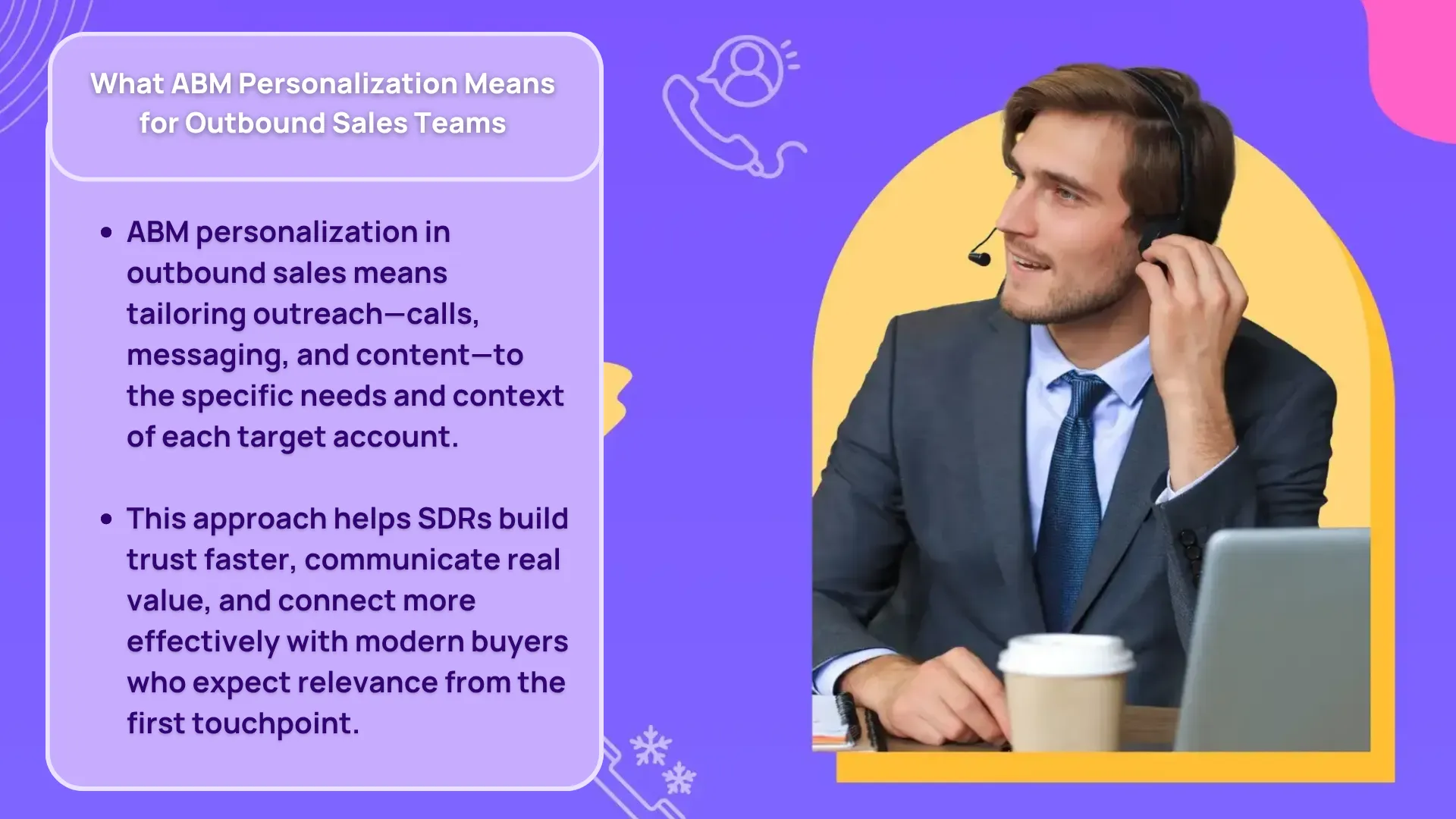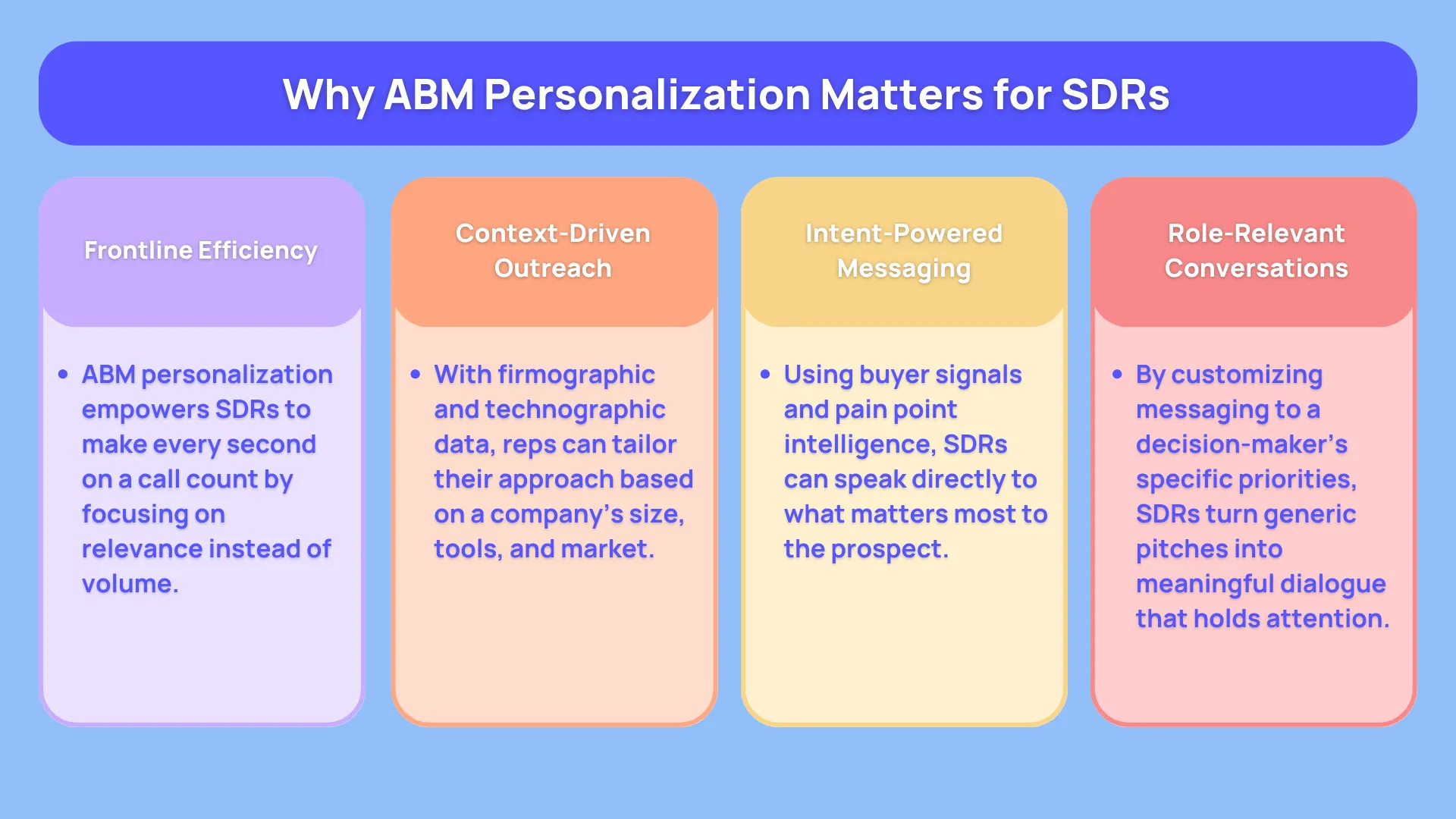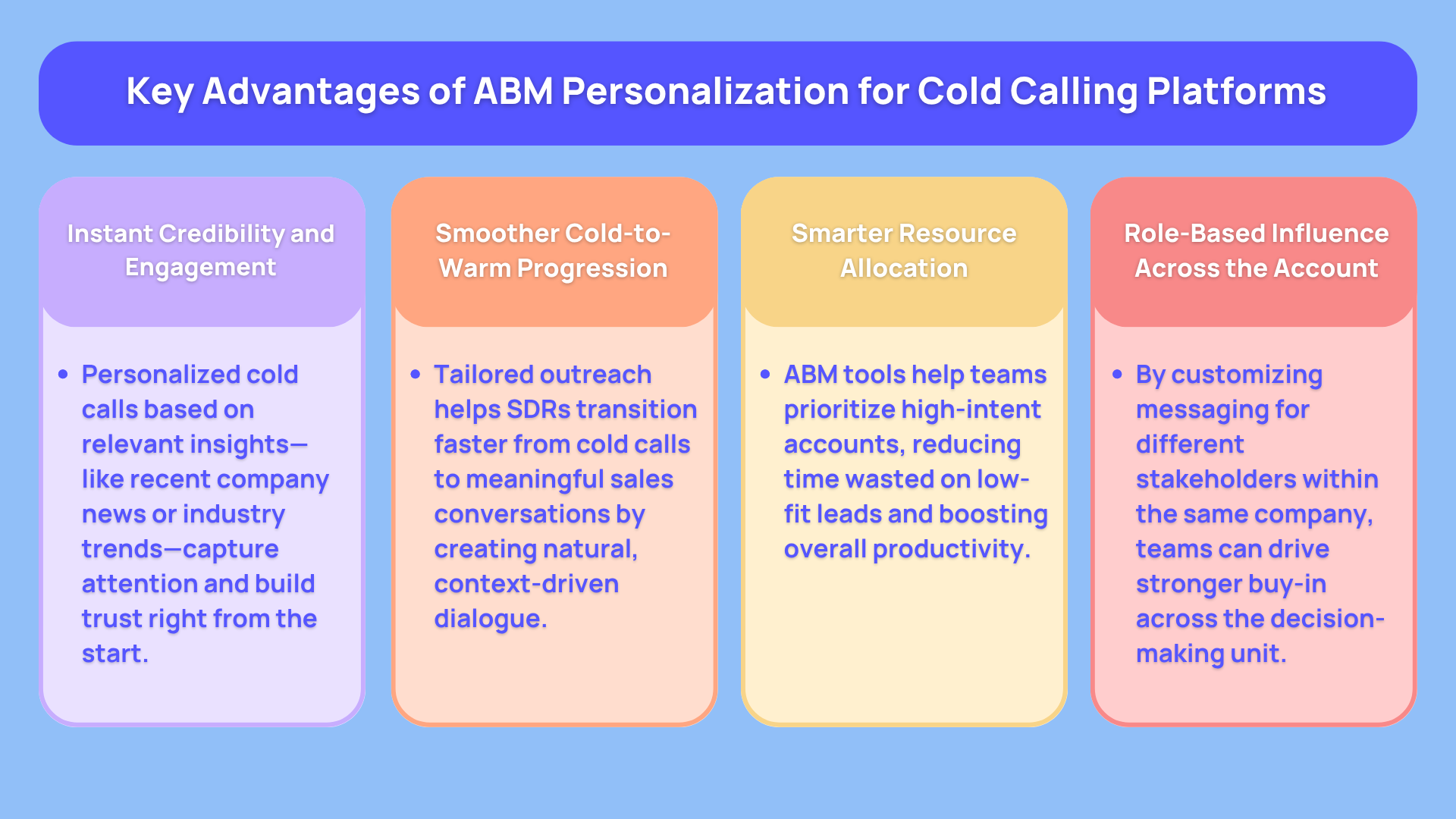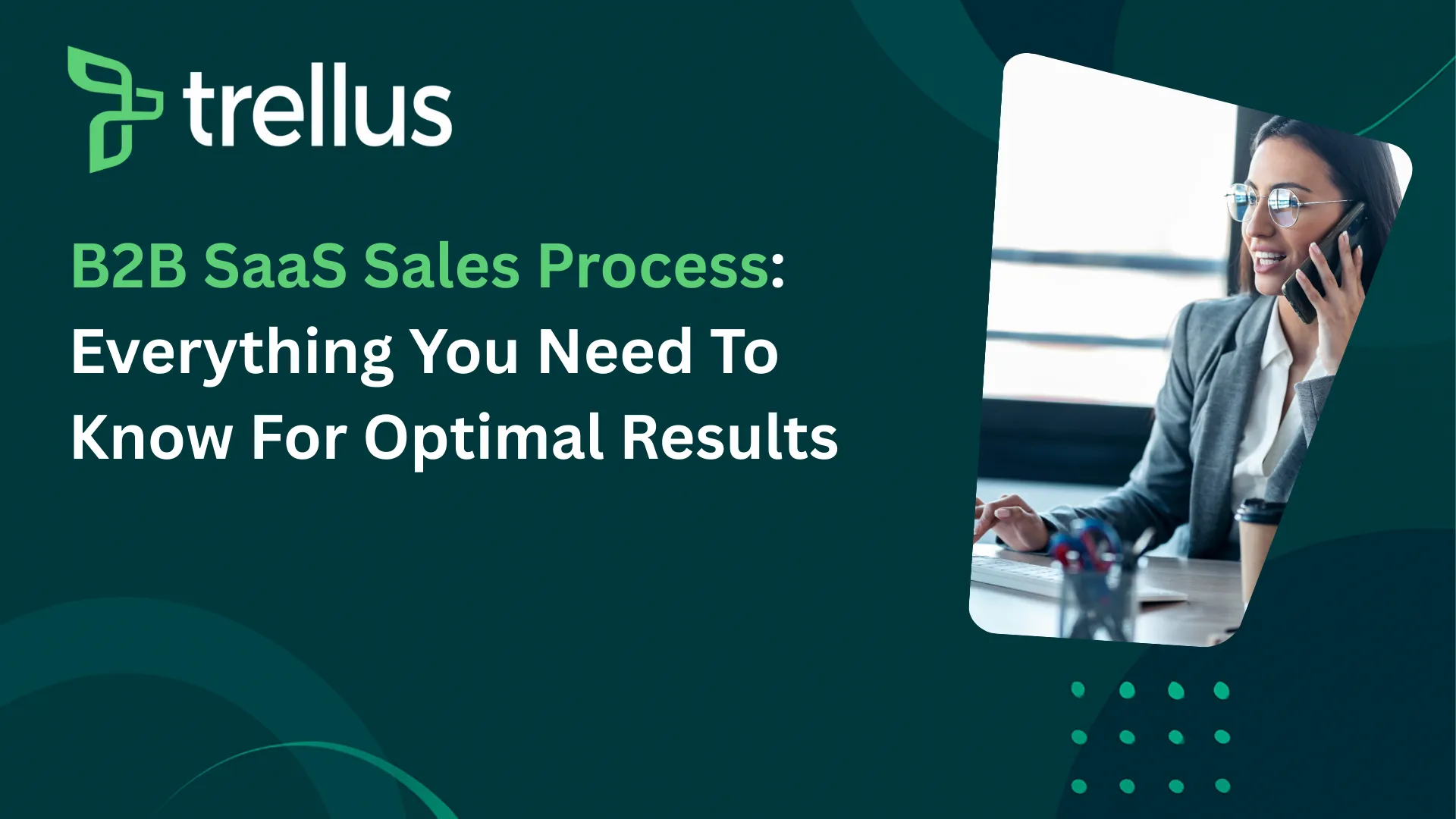
Our Top Picks


Account-based marketing (ABM) isn’t just a buzzword in the B2B world anymore—it’s a strategy that can radically transform how outbound sales teams engage with their highest-value prospects. At the heart of ABM is a critical element that many outbound sales businesses underestimate: personalization.
When the entire strategy is thoughtfully woven into outbound strategies, it helps SDRs and AEs cut through the noise, connect meaningfully, and accelerate conversions.
This post highlights the ABM strategy from an outbound sales company’s requirements perspective. We have also touched base on other issues that coincide with cold calling platforms.
But the reason for crafting this write-up was to fill you in on ABM’s potential as not just another marketing strategy that’s normally viewed as something limited to web or ecommerce businesses.
There’s a lot more to it than meets the eye.
What ABM Personalization Means for Outbound Sales Teams

ABM personalization refers to tailoring content, messaging, campaigns, even cold calls, and touchpoints around the specific context of individual target accounts.
For outbound sales businesses that rely on cold calling, this means SDRs aren’t just dialing randomly—they’re reaching out with relevance, context, and precision.
These days, your average “modern buyer” expects to be seen, heard, and understood. And that expectation doesn't disappear once the cold call starts. ABM personalization for outbound sales businesses creates a path to:
- Communicate directly to the buyer's real problems.
- Share content and value that aligns with their stage in the buyer’s journey.
- Establish trust faster in a highly competitive landscape.
Think of it like this: personalized outbound isn’t about doing more; it’s about doing better with the same effort.
Why ABM Personalization Has Become Non-Negotiable
The data is loud and clear: 74% of B2B buyers expect vendors to understand their business needs and challenges before making a pitch. And 66% expect personalized interactions across every stage of their buyer journey.
This isn’t just a preference—it’s a requirement. ABM personalization has become essential because it:
- Boosts engagement with decision-makers who are tired of generic outreach.
- Helps position your brand as a strategic partner instead of just another vendor.
- Enables sales teams to have smarter conversations with less effort.
- Makes cold calling significantly more effective through warm, tailored narratives.
Outbound sales teams that operate without personalization are left shouting into the void, while others are having valuable one-on-one conversations that convert.
ABM Personalization for Outbound Sales Calling: A Game-Changer for SDR Success
For outbound sales teams that rely on SDRs making cold and warm calls, Account-Based Marketing (ABM) personalization isn't just nice to have—it’s essential.
Traditional cold outreach often suffers from poor response rates, mainly because the messaging feels generic or irrelevant. ABM flips that on its head by aligning every touchpoint—especially those critical phone calls—with laser-focused, account-specific personalization.
Why ABM Personalization Matters for SDRs

SDRs are on the front lines of outbound sales. Whether they’re dialing cold or following up warm, every second on the phone counts. That’s where ABM personalization steps in—helping SDRs cut through the noise with precision-targeted conversations.
Instead of calling into an account with a vague script, SDRs using an ABM-powered strategy go in with:
- Firmographic context (company size, industry, location)
- Technographic insights (cold calling tools or platforms the company uses)
- Pain point intelligence (based on buyer persona and company challenges)
- Buyer intent signals (from web visits, ad interactions, or past engagement)
- Role-specific messaging (tailored to the decision-maker’s priorities)
This allows reps to speak directly to the prospect’s reality. Not in a general “we help businesses grow” kind of way, but something like:
“I saw your team recently scaled your SDR headcount—are you currently evaluating any tools that can help streamline your outreach or parallel dial at scale?”
Now that’s the kind of call that makes someone stay on the line.
How ABM Personalization Supports Cold and Warm Calls
Whether it's a cold introduction or a follow-up from a content touchpoint, ABM helps SDRs contextualize their outreach:
- Cold Calls: SDRs approach with pre-call intelligence pulled from ABM tools. This could include custom talking points based on a prospect’s recent funding round, hiring spree, or even changes in tech stack—making it feel less like a “cold” call and more like a tailored conversation.
- Warm Calls: ABM integration ensures SDRs know exactly how the prospect has interacted with the brand—be it downloading a case study, engaging with a LinkedIn post, or attending a webinar. They can build continuity from those signals into their call:
“Hey Alex, I saw you downloaded our guide on improving outbound sales efficiency—curious, are you facing bottlenecks with rep productivity or call connect rates?”
Key Advantages of ABM Personalization for Cold Calling Platforms

Cold calling is alive and well, but the rules have changed. Buyers don’t want to be pitched—they want to be helped.
ABM personalization for cold calling platforms reshapes what a cold call feels like. It can quickly turn an unsolicited call into a welcomed conversation.
Let’s unpack the most tangible benefits outbound sales businesses can gain through ABM personalization:
1. Stronger Engagement From the First Touch
Calls grounded in personalized insights create immediate relevance. Whether it's referencing a recent funding announcement or commenting on a strategic shift at the company, showing you did your homework fosters instant credibility.
2. Improved Cold-to-Warm Transition
Personalized messaging doesn't just increase pickup rates; it makes it easier to move from cold outreach into active deal conversations. Context builds connection.
3. Efficient Use of Resources
Rather than spending time chasing leads with no intent, personalization platforms allow teams to focus on high-value accounts showing real signs of readiness.
4. Higher Conversion Rates
The alignment between personalized messaging and account-specific pain points shortens the sales cycle and increases your likelihood of winning.
5. Better Multi-Stakeholder Buy-In
In enterprise B2B sales, you're rarely selling to one person. ABM personalization means you can craft different messaging tracks for different roles in the same account—appealing to each stakeholder on their terms.
Personalization in ABM: What It Looks Like in Practice
While the phrase "personalized ABM" sounds complex, it comes down to how well you know your audience and how thoughtfully you reflect that in every interaction.
Here are some practical ways outbound sales teams personalize their ABM outreach:
- Hyper-personalized emails that reflect specific initiatives, KPIs, or pain points of the account.
- One-to-one landing pages created specifically for target accounts, featuring relevant messaging and case studies.
- Customized video intros that explain how your product solves their unique challenges.
- Web personalization tools that adapt your homepage or product page to reflect an account’s industry or role.
- Smart cold calling scripts that vary based on account tier, intent data, or trigger events like leadership changes.
Personalization isn’t only about being clever. It’s about being relevant, timely, and helpful.
ABM Personalization Strategy: A 5-Step Framework
Creating a personalized ABM strategy that enhances outbound sales performance doesn’t have to feel overwhelming. Here's a clear roadmap for building your approach:
Step 1: Create a Precise ICP and Tiered Account List
Begin with clarity. Identify your ideal customer profile (ICP) and build a detailed account list. Go beyond firmographics like industry and company size. Think about:
- Organizational priorities
- Pain points your solution solves
- Buying committee structure
- Digital behavior and intent signals
Segment these accounts into Tier 1, Tier 2, and Tier 3 based on value and probability to close. Your level of personalization will differ across tiers.
Step 2: Build Robust Personas for Each Account Tier
Within your target accounts, identify the key stakeholders: decision-makers, influencers, and blockers. Understand their motivations, responsibilities, KPIs, and how they define success.
These personas should include:
- Role-specific challenges
- Preferred content formats
- Buying triggers
- Objections commonly raised
Step 3: Match the Right Channel to the Right Persona
Not all stakeholders engage on the same platforms. Some might prefer LinkedIn DMs, others might respond better to cold calls or email.
Choose your outreach methods based on persona preferences:
- Executives: Email + Direct Mail + Executive Briefs
- Mid-level Managers: LinkedIn + Webinars
- Technical Users: Product Demos + Whitepapers
Make your outreach feel seamless across channels with consistent messaging.
Step 4: Invest in the Right Personalisation Platform or Tool Stack
Great personalization requires great tech. Use tools that help uncover buyer intent, identify anonymous web visitors, and deliver dynamic, personalized experiences.
Top personalization tools and platforms for ABM:
- 6sense: Best for identifying buying intent and predicting account behavior.
- Demandbase: Excellent for targeting and serving personalized ads across the buyer journey.
- Mutiny: Enables non-technical teams to create personalized website experiences.
- Clearbit: Helps enrich contact and account data to sharpen personalization.
- Vainu: Especially strong for European account insights.
These platforms are purpose-built for outbound teams aiming to make every touchpoint count.
Step 5: Execute, Measure, and Refine Continuously
Once your campaigns are live, measurement becomes the name of the game. Your personalization strategy should be flexible and adaptive.
Key metrics to track:
- Account engagement levels (site visits, email opens, call response rate)
- Influence on pipeline velocity
- Conversion rate across tiers
- Campaign-attributed revenue
Use these insights to refine your scripts, content, and account targeting. Personalization only improves with iteration.
ABM Personalization Tactics That Outbound Teams Can Adopt Today
To help SDRs and outbound teams succeed with minimal friction, here are some plug-and-play tactics that work across industries:
Use Intent Data for Timing Cold Calls
Intent data reveals which accounts are researching solutions like yours. Combine this with sales intelligence to time your outreach precisely.
Create Sales Scripts Based on Persona Profiles
Rather than a single generic pitch, create modular scripts with different openers, objection handling, and CTAs based on the persona you’re contacting.
Launch Account-Specific Ads Before Calls
Running targeted LinkedIn or display ads for a week before an outreach sequence can help build familiarity. Prospects are more likely to respond when they recognize your brand.
Send Pre-call Content with a Personal Note
If you know the buyer is interested in a topic, send them a relevant case study or blog post with a quick message. This softens the ground before your cold call.
Offer Personalized Demos or Microsites
Create a custom demo environment or microsite for high-value accounts. Walk them through how your product supports their specific goals.
Where Web Personalization Tools Fit into ABM
Web personalization tools have become essential in outbound-driven ABM strategies. They allow your website to become part of the conversation, even before the SDR calls.
When a target account visits your website, tools like Mutiny or Clearbit can:
- Change the hero text to mention their industry or use case.
- Feature relevant case studies or testimonials.
- Show pricing tiers based on company size.
That kind of personalized experience builds credibility instantly and increases the chance of your next outbound touch converting.
It Isn’t a Gimmick—It’s a Revenue Engine
ABM personalization for outbound sales businesses is no longer optional.
Regardless of whether you're calling into a CFO’s office or emailing a RevOps leader, the expectation is that you understand their world. And when you do, your sales efforts stop feeling like a pitch and start becoming a conversation.
From web personalization tools to advanced personalization platforms, technology has made scalable personalization possible. But the real magic happens when smart sales teams pair these tools with empathy, insight, and a focus on delivering value.
Outbound calling isn’t dead—generic outbound is. ABM personalization is what brings it back to life.







